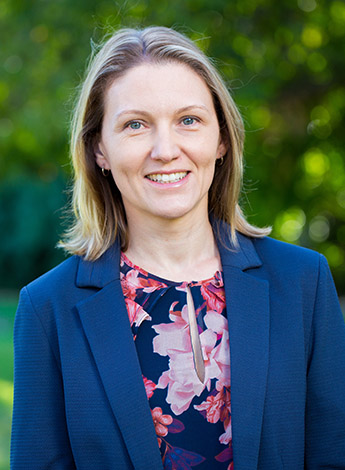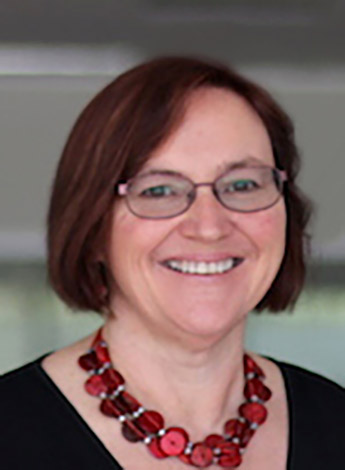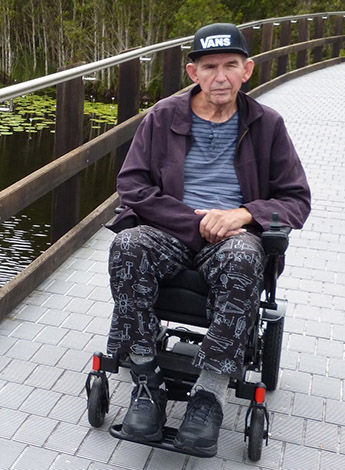
Do we need a better system for long-term stroke care?

In Australia, there is no clear pathway for stroke survivors to find and fund ongoing care, with options including the National Disability Insurance Scheme, aged care and self-funded services, and physiotherapists involved in stroke rehabilitation say stroke survivors deserve better.
Stroke is a leading cause of disability in Australia and more than 445,000 Australians live with the effects of stroke.
In 2020, it was estimated that there would be 27,428 strokes experienced by Australians at a cost of $6.2 billion dollars in direct financial costs and a further $26 billion in premature mortality and lost wellbeing due to short and long- term disability (Deloitte 2020).
In an article published last year in The Medical Journal of Australia, physiotherapist Dr Kate Scrivener APAM MACP and her colleagues highlighted the need for better coordination of long- term care and rehabilitation for survivors of stroke in Australia (Scrivener et al 2022).

Dr Kate Scrivener has highlighted a need for better coordination of long term stroke care.
‘We have focused on the acute phase of care— not only the first few hours and days, but the hospital admission period.
'We’re not focusing enough on the months or years after stroke when the person is out living in the community,’ says Kate, who is a researcher and senior lecturer in physiotherapy in the Department of Health Sciences at Macquarie University.
‘We give people support early on and then almost have a cut-off point where the health system forgets about them.’
A large part of the problem is that stroke care straddles the healthcare, aged care and disability sectors.
The healthcare system takes care of the acute and subacute phases in hospital and in inpatient/outpatient rehabilitation.
Once a stroke survivor finishes rehabilitation, however, they are discharged to the care of their GP and that’s when it starts getting complicated.
‘There’s no consistent program of support, so from that point on it’s very variable in terms of what services people will get.
'Some people may be able to access physiotherapy if they’re lucky enough to be eligible for the National Disability Insurance Scheme [NDIS], while other people won’t have very much access at all,’ Kate says.
There are several ways for the stroke survivor to access ongoing rehabilitation services—through the aged care or disability sectors or through Medicare via a Chronic Disease Management Plan managed by a GP, which offers up to five subsidised allied health visits annually.
Because many survivors of stroke are not able to work, health insurance and personal funds may be stretched to cover their needs, including carers, allied health and transport costs.
In the disability sector, the NDIS has strict eligibility criteria—stroke survivors must have had their stroke before they are 65 and must prove that they have a permanent and significant disability.
While it can be difficult to navigate, it does provide access to ongoing allied health services and programs as well as other services.

Dr Natalie Fini says patients can access more services through the NDIS.
‘At least we have the NDIS now,’ says the University of Melbourne’s Dr Natalie Fini APAM MACP, who recently finished her term as chair of the APA’s Neurology national group.
‘Patients can access so much more—it’s phenomenal compared to what they could get before—but it’s so variable.
'If you don’t know what to ask for, if you don’t have someone advocating or a good planner, you may not get what you need.’
Stroke survivors who are 65 years or older when they have their first stroke must receive their care through the aged care sector, which offers a variety of community rehabilitation programs as well as home- based care or, for those whose care needs are high, admission to an aged care residence.
‘The recent Royal Commission [into Aged Care Quality and Safety] noted that such services are currently inadequate and not focused enough on people’s participation or life goals. Anecdotally, people wait a long time for those services and often have to co-fund them,’ Kate says.
Natalie agrees, adding that since the COVID-19 pandemic, there has been a push to move people out of hospitals as quickly as possible.
‘Many people aren’t even given a chance to get to rehab to make those gains.
'They’re just shipped straight home with full care or straight to a nursing home.
'It’s awful because they have a lot of potential to be functioning much better than they are and some of them could even get home with the right rehab,’ she says.
Flinders University senior research fellow Dr Elizabeth (Liz) Lynch says that decisions are often made quite quickly in acute stroke units about which patients will benefit from rehabilitation and this decision has implications for how well the patient recovers from the stroke.
Survivors of mild strokes are more likely to be sent home, while patients who had a moderate stroke may go to a rehabilitation facility for inpatient treatment.
Those who had a severe stroke are generally discharged into residential care—a nursing home or aged care facility.

Dr Liz Lynch has looked at whether all stroke survivors have equal access to rehabilitation services.
‘If you’re going to inpatient rehab or a nursing home, you tend not to get much therapy during the acute hospital stay because the clinical staff’s time is really precious.
'If you’re going home, they need to quickly work you up because you need to be able to get home.
'And if they’re not sure if you’re going to rehab or not, they will spend more time with you to try to figure it out,’ Liz says.
As you might expect, the patients who are lucky enough to go to inpatient rehabilitation centres tend to improve their function, but stroke survivors sent to residential aged care homes, usually the ones who have the most severe strokes, don’t do well at all (Lynch et al 2022).
‘Stroke is considered an acute condition from which people recover, but it isn’t really because there’s long- lasting disability.

Professor Cath Dean says many stroke survivors can't access the services they need.
'We have done remarkably well in the acute medical management of stroke, but there are many people with mild, moderate or severe disability arising from their stroke who can’t access the services they need and their ability to participate and make choices for themselves is compromised,’ says Professor Catherine Dean APAM, Deputy Dean of Education and Employability in the Faculty of Medicine, Health and Human Sciences at Macquarie University.
Rehabilitation—whether inpatient or outpatient—typically focuses on specific goals, such as being able to navigate stairs, walk a certain distance or regain the use of one’s hand or arm. But many stroke survivors have ongoing mobility issues once their rehabilitation has finished.
‘We know that some people will actually get worse once they stop rehabilitation, while others, once they go home and experience life again, will find that they’ve got all of these other goals—activities that they can’t yet perform.
'Rehab only gets you to a certain threshold or base level of mobility,’ Kate says.
‘It’s very individual—two people could walk out at exactly the same performance level, they might measure exactly the same, and one of those individuals would have lots of goals and things they would like to achieve and one might be happy that they can do everything in their life that they want to do.’
Natalie says that many survivors of stroke might benefit from having bursts of rehabilitation to help them achieve specific goals or even just to ‘tune up’.
‘Perhaps stroke survivors could get some funding each year for therapy.
'They could do that in a burst and get the skills they need for what’s happening in their life right now, because things change.
'A younger person might start a new job with more physical demands or they might have children who create different physical demands as they get older.
'An older person might need a hip or knee replacement, affecting their disability.
'It depends on life stages and life events—to be able to access it when it is needed would be great,’ she says.
Added to that is the need to keep stroke survivors moving and exercising rather than sitting around— sedentary behaviour is a big risk factor for further strokes.
Physiotherapists across Australia have developed rehabilitation programs to address physical activity in stroke survivors, but there is no clear pathway to implement and fund these programs on an ongoing basis.
Natalie recently completed a longitudinal study of stroke survivors, looking at their physical activity and cardiovascular risk factors across a two-year span starting when they finished rehabilitation (Fini et al 2021).
Natalie’s study found that participants’ adherence to the guidelines for physical activity decreased by up to 50 per cent during the follow-up period.
‘We need regular multidisciplinary reviews of these people because they’re just going to get more and more unhealthy,’ she says.
Kate says it’s clear to people working in stroke rehabilitation that something needs to be done.
She believes it would be more effective to cover all stroke under a disability model regardless of age.
Ideally, stroke survivors would move from the rehabilitation programs to a program of regular multidisciplinary reviews, with assistance to find services as needed.
Another factor is the variability of access to programs in different health districts, between Australia’s major cities and in rural and regional Australia.

Physiotherapist Alison Wighton says stroke survivors can't always easily access appropriate rehabilitation programs.
‘Different local health services will offer different levels of assistance to someone who’s gone home following a stroke,’ says Alison Wighton APAM MACP, a physiotherapist and clinic team leader at Concentric Healthcare Services, which is a national network of multidisciplinary rehabilitation clinics.
‘There may be clinics at the hospital or home-based allied health services specifically for people who have had a stroke.
'Or, if you live on the other side of the city, you may find that your local hospital doesn’t offer anything like that.
'So there’s a lot of inequity when it comes to access to services, particularly once people go home.’
Alison says one factor is the introduction of the NDIS, which has led hospitals to reduce their outpatient offerings as it is assumed that people will be able to access similar programs through the NDIS.
‘We know now through lived experience of the NDIS that it’s not always the case.
'I’ve worked with people whose application to the NDIS was rejected after a stroke because it was deemed that their disability wasn’t severe enough or affecting their day-to-day activities enough.
'That has really limited those people’s ability to achieve their goals and to continue their rehab journey to get back to what they were doing prior to their stroke,’ says Alison.
A big issue when it comes to navigating the NDIS or aged care services is their complexity.
Even the language used to describe disabilities and services can be complex.
‘The NDIS is quite particular about the types of language we use in these reports and if the therapist in the hospital is not aware of that, it can have a real impact on whether or not the person is accepted onto the NDIS.
'We need to be careful when we’re communicating with them not to use words like “rehab” and instead to use phrases like “building somebody’s capacity”,’ Alison says.
Ultimately, the stroke survivors who get the most out of the services they are eligible for are the ones who can advocate for themselves or who have a family member who can speak up for them.
‘The NDIS works really well if you are not cognitively impaired in any way and are a very good advocate for yourself.
'Otherwise, it’s incredibly difficult to navigate and you shouldn’t have to employ people to navigate those systems,’ says Catherine.
Gillian Mason, a stroke researcher and physiotherapist at the Hunter Medical Research Institute in Newcastle, agrees.
‘You shouldn’t need to front up with all this expertise, having done all this research and having figured out exactly how to describe your lived experience in those technical ways.
'You should be able to just say, what I can’t do is use my left hand when I need to do these things in my life or I can’t get to work because I can’t drive anymore and I cannot safely get to a bus, so I need supports.
'It should be that simple.
'As it is now, the system doesn’t allow for the reality that stroke-related disability and neuro function in general is dynamic.
'To get access to NDIS supports, you need to convince an NDIS assessor that you’re never going to improve, therefore rehab isn’t appropriate—and that isn’t even consistent with how we know the body works.’
Liz says there is more we can do to prepare stroke survivors for life outside the hospital environment.
‘When someone has a stroke, often they’ve gone into hospital having previously been fit and independent and capable of doing whatever they want to do and then they leave hospital with a chronic health condition that they have to manage for the rest of their lives.
'I don’t think we’re mindful enough about educating people on managing this chronic condition that will be with them forever.
'Even if they don’t have particularly big physical disabilities, they still have the risk of secondary stroke,’ she says.
A good option if you’re young enough
Seven years after his stroke, Clive Kempson has several significant disabilities—one arm is, in his words, ‘sort of useless’, with minimal function.
He has gait issues and foot drop on the same side and, as the result of a fall, he has damaged the knee in his ‘good’ leg.

Clive Kempson accesses physiotherapy programs through the NDIS.
‘I’ve never had any cognitive issues.
'But I get tired after the stroke and I can’t walk fast or run because my gait pattern and hip won’t let that happen.
'For me, accepting that it’s going to be this way for the rest of my life was probably the hardest part,’ says Clive.
Clive had 12 months of physiotherapy rehabilitation after he left hospital and two and a half years of occupational therapy through community rehabilitation programs.
Once that finished, he started looking into the new NDIS program, which was rolling out in his area.
In his early 50s at the time of his stroke, Clive was young enough to enrol—the NDIS is not available to stroke survivors who are 65-plus when they have their stroke.
These days he gets 35 hours a year for physiotherapy and another 35 hours a year for occupational therapy as well as some other services such as podiatry and cleaning.
Clive self-manages his NDIS program rather than working with a support coordinator and earlier this year renewed his program for two years.
Although he is happy overall with the funding he has, he gets a bit frustrated with the amount of paperwork it entails.
‘They want documentation from everybody about me.
'But when my therapists recommend a continuing service with 52 hours a year, the NDIS doesn’t give you that.
'I get 35 instead with no explanation,’ he says.
‘They continually ask about progress, but they also tell you that they’re not a rehab service.
'I’m not in physio for rehab—why do you need to know if I’m making progress?
'When I pose that to them, they say, “Oh, it’s just…”
'It’s obviously one of the things they have to ask.
'At the moment I think I’ve got adequate services, although there are services that the NDIS doesn’t cover that I think they should.’
Overall, though, Clive says it’s a great option for him and he feels fortunate to have access to the NDIS.
‘I have to say, I’m glad I live here because from what I can gather about the services overseas, they’re nowhere near as good.
'We have what I would consider one of the best services post-stroke in the world, even though I think it needs improving,’ he says.
His main beef with the NDIS service is the age limit—because he had his stroke before he turned 65, he will remain eligible for life under the current scheme.
Older survivors of stroke have to navigate the My Aged Care system instead.
‘I think there should be a continuum of care, from the acute to the subacute to community to NDIS.
'I don’t necessarily agree with the fact that once you hit 65, you then can’t be eligible for NDIS as a new participant,’ Clive says.
‘The participation in NDIS should be for everybody.’
Navigating the complex world of aged care
Michael Roth (pictured above) went from an active, independent retirement to being completely dependent on his wife Tess when he had a stroke four years ago.
Michael was hospitalised for three and a half months, after which he was able to access community rehabilitation for six months through the Sutherland Transitional Aged Care Service.
Since then he has bounced around between different programs through different providers, not helped by the various lockdowns and restrictions caused by the COVID-19 pandemic.

Michael Roth has found it difficult to access suitable programs through My Aged Care.
He has paralysis on his right side and has developed spasticity in his arm.
In addition, his mobility has significantly deteriorated since his initial rehabilitation.
Michael is frustrated by several issues with the system at the moment.
The biggest problem, he says, is its piecemeal nature, due to the way that care is allocated through My Aged Care.
He and Tess are constantly looking for suitable rehabilitation programs that aren’t too far away from their home in the southern suburbs of Sydney and that actually have open spots for new participants.
Once they find them, they have to apply for them and hope that funding is approved.
Once the funding allowance has been used up for a particular program, Michael has to apply all over again for the same or a different program.
‘Don’t get me wrong, I’m grateful for the help I can get, but it’s very frustrating sometimes,’ he says.
Another issue is the lack of continuity.
‘Through the Commonwealth Home Support Programme, I could get a physio to come to my place once a week for half an hour but the limit was 15 weekly sessions.
'He stopped last Wednesday.
'Then I applied for a two-month treatment program, with a physio coming once a week and an exercise physiologist once a week.
'To get that, you’ve got to jump through all these hurdles.
'You have to apply again, you’ve got to get another number and you’ve got to see if they have any vacancies,’ Michael says.
‘I would have liked to stay with the same physio.
'I don’t know why you can’t employ somebody and go for the whole year.’
Michael says he could get a home care package through My Aged Care, but most of the programs offered are not suitable for his needs.
So he and Tess continue to look and advocate for services.
Michael is thankful that they are able to navigate the system themselves.
‘I’m not stupid; I know what I’m doing.
'Some people haven’t got the capacity to do all that, but my mind is actually quite good—I can remember very well and I can communicate with my computer.
'A lot of people my age, they don’t have those skills either.’
- References
-
Deloitte Access Economics. The economic impact of stroke in Australia, 2020. Stroke Foundation, November 2020. https://www2.deloitte.com/content/dam/Deloitte/au/Documents/Economics/deloitte-au-dae-economic-impact-stroke-report-061120.pdf (viewed January 2023).
Scrivener, K., Dean, C., Cameron, I.D. and Ada, L. (2022), Stroke in Australia: long term survivors have fallen into a black hole. Med J Aust, 217: 290-291. doi.org/10.5694/mja2.51691
Fini NA, Bernhardt J, Churilov L, Clark R, Holland AE. Adherence to physical activity and cardiovascular recommendations during the 2years after stroke rehabilitation discharge. Ann Phys Rehabil Med. 2021 Mar;64(2):101455. doi.org/10.1016/j.rehab.2020.03.018
Lynch EA, Labberton AS, Kim J, et al. Out of sight, out of mind: long-term outcomes for people discharged home, to inpatient rehabilitation and to residential aged care after stroke. Disabil Rehabil 2020; 44: 2608-2614. doi.org/10.1080/09638288.2020.1852616
-
© Copyright 2024 by Australian Physiotherapy Association. All rights reserved.





